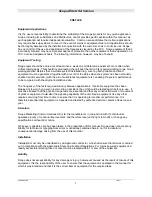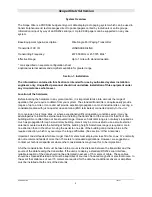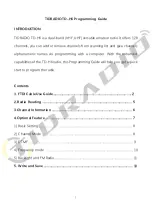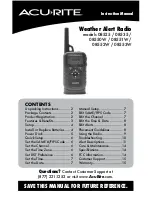
Scope Xlite USA Version
XliteUSA 01/00
Issue 1
11
Section 3: Technical Information
This section provides a more in depth understanding of how messages are formatted for serial
communication from a host. It provides useful information for hook up to serial data devices or for
programming pagers and understanding the system configuration. Depending upon the issue of
software resident in the controller the message length will be a maximum of either 512 or 2000
characters.
Check before quoting or ordering.
Calling Pagers
Pagers all use 7 digit numeric addresses which enables the system to support thousands of
pagers without identity clashes. Most pagers will support multiple addresses (sometimes referred
to as CAP codes, RIC’s or identities ID’s). This enables the pager not only to respond to its own
unique address but also to respond to group or global addresses.
These real 7 digit numeric codes are often substituted for shorter logical numbers which are
easier to remember and more meaningful. It also allows, in most cases logical pager numbers to
be generated to match the customers internal telephone extension numbers. Under these
conditions the host or specialty program within the transcoder will perform an algorithm on the
data string received to convert the simpler logical number back into a real 7 digit number for
transmission.
The real 7 digit pager numbers are always spaced 8 digits apart. This is a function of the
POCSAG standard, it allows for eight frames in which the pager identity can reside. Scope uses
frame 0 as a default for most systems as this provides for the fastest pager response when
called.
To avoid system identity clashes, transcoders are provided with a base number within the range
of 1000 to 1,999,000. If for example a base address of 0100,000 is applied to a transcoder, the
first real pager number will 0100,008 followed by 0100,016 and so on.
Logical pager numbers are normally used on systems fitted with the telephone interface and
those which are interfaced to personal computers. The algorithm would perform the following
function:-
For example take the logical pager number of 123
The logical pager number 123 will be multiplied by 8 and then added to the base number to
provide the 7digit real number
Logical
No
Base
No Real
No
123
x
8
=
984
+
0100,000
=
0100984
Pager address 1, or ID 1 is normally reserved as the personal identity for that specific pager.
Other addresses, of which there can be 6 or more, can be tagged to specific pagers to form
selected groups. Address 2 or ID 2 could, for example, be used for all pagers to formulate a
global call.
Address codes can be divided between full addresses and sub addresses. Full addresses can
allow four different bleep types, A, B, C or D, whereas sub-addresses will only accommodate a
fixed bleep type. A status line of information will normally be provided on the pager screen which
will highlight the type of bleep sent together with other status information.






























